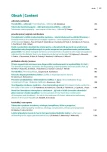Von Hippel-Lindau syndrome – two sides of the same coin
Authors:
Patrícia Páleníková 1; Monika Adamcová 1; Igor Šturdík 1; Beáta Ftáčniková 2; Lucia Copáková 3; Juraj Payer 1
Authors‘ workplace:
V. interná klinika LF UK a UNB, Nemocnica Ružinov, Bratislava, Slovenská republika
1; I. rádiologická klinika LF UK, SZU a UNB, Nemocnica Ružinov, Bratislava, Slovenská republika
2; Oddelenie lekárskej genetiky Národného onkologického ústavu, Bratislava, Slovenská republika
3
Published in:
Vnitř Lék 2016; 62(12): 1004-1008
Category:
Reviews
Overview
Von Hippel-Lindau syndrome (VHL) is a rare genetic disease. Its incidence is 1 : 36,000, there is the familial occurrence in 80 % of cases , the remaining cases are de novo mutations. The disease is caused by the highly penetrant mutations in the VHL gene (3p25.3) and is characterized by the occurrence of benign and malignant neoplasms. The most common VHL tumors are the tumors of the retina, brain and spinal hemangioblastomas, renal cell carcinoma, pheochromocytoma, endolymfatic sac tumors and pancreatic tumors and cysts. The mean age of the VHL patients during the diagnosis is 20–40 years. The diagnosis can be confirmed by a positive family history and the presence of one of the typical tumor. In case of no family history, the diagnosis has to be assessed by the presence of the multiple tumors. The clinical signs and prognosis of VHL depend on the location and extent of the tumors. The life expectancy is 50 years. The most common causes of death are complications of the renal cancer and the brain tumors. The treatment requires a multidisciplinary collaboration through the whole life of patients. This 2 cases report we demonstrate the differences among the patients with de novo mutations disease and the patient with familial incidence.
Key words:
pheochromocytoma – renal cell carcinoma – von Hippel-Lindau syndrome
Sources
1. Maher ER, Yates JRW, Harries R et al. Clinical Features and Natural History of von Hippel-Lindau Disease. QJM 1990; 77(283): 1151–1163.
2. Maher ER, Kaelin WG Jr. von Hippel-Lindau Disease. Medicine (Baltimore) 1997; 76(6): 381–391.
3. Richards FM, Phipps ME, Latlf F et al. Mapping the Von Hippel-Lindau disease tumour suppressor gene: identification of germline deletions by pulsed field gel electrophoresis. Hum Mol Genet 1993; 2(7): 879–882.
4. Plate KH, Breier G, Weich HA et al. Vascular endothelial growth factor is a potential tumour angiogenesis factor in human gliomas in vivo. Nature 1992; 359(6398): 845–848.
5. Glasker S, Neumann HPH, Koch CA et al. Von Hippel-Lindau Disease. In: De Groot LJ (ed), Beck-Peccoz P, Chrousos G et al: Endotext. South Dartmouth (MA): MDText.com; 2000. Dostupné z WWW: <https://www.ncbi.nlm.nih.gov/books/NBK279124/>
6. Hes FJ, Höppener JWM, Lips CJ. Pheochromocytoma in Von Hippel-Lindau Disease. J Clin Endocrinol Metab 2003; 88(3): 969–974.
7. Maher ER, Neumann HPH, Richard S. von Hippel-Lindau disease: A clinical and scientific review. Eur J Hum Genet 2011; 19(6): 617–623. Dostupné z DOI: <http://dx.doi.org/10.1038/ejhg.2010.175>.
8. Plevova P, Novotny J, Křepelova A. Von Hippel- Lindauova choroba. Klinická onkologie 2009; 22(Suppl 1): S23-S24. Dostupné z WWW: <http://www.linkos.cz/files/klinicka-onkologie/149/3449.pdf>.
9. Shuin T, Yamasaki I, Tamura K et al. Von Hippel-Lindau disease: molecular pathological basis, clinical criteria, genetic testing, clinical features of tumors and treatment. Jpn J Clin Oncol 2006; 36(6): 337–343.
10. Kaelin WG. Von Hippel-Lindau disease. Annu Rev Pathol 2007; 2: 145–173.
11. Von Hippel-Lindau Syndrome overview. American Society of Clinical Oncology. Editorial Board April 2013. Dostupné z WWW:
12. Zelinka T, Widimský J Jr. Feochromocytom – proč je jeho časná diagnóza pro pacienta důležitá? Vnitř Lék 2015; 61(5): 487–491.
13. Lee JS, Lee JH, Lee KE et al. Genotype-phenotype analysis of von Hippel-Lindau syndrome in Korean families: HIF-α binding site missense mutations elevate age-specific risk for CNS hemangioblastoma. BMC Med Genet 2016; 17(1): 48. Dostupné z DOI: <http://dx.doi.org/10.1186/s12881–016–0306–2.
14. Vaňuga P, Pura M, Kreze A Jr. Genetické pozadie nádorov adrenomedulárneho a extraadrenálneho chromafinného tkaniva – aktuality. Vnitř Lék 2010; 56(12): 1296–1302.
15. McNeill A, Rattenberry E, Barber R et al. Genotype-phenotype correlations in VHL exon deletions. Am J Med Genet A 2009; 149A(10): 2147–2151. Dostupné z DOI:
Labels
Diabetology Endocrinology Internal medicineArticle was published in
Internal Medicine

2016 Issue 12
Most read in this issue
- Thrombophilia
- Oral antidiabetic drugs in treatment of type 1 diabetes mellitus
- Takotsubo cardiomyopathy: incidence, etiology, complications, therapy and prognosis
- Coffee as hepatoprotective factor
